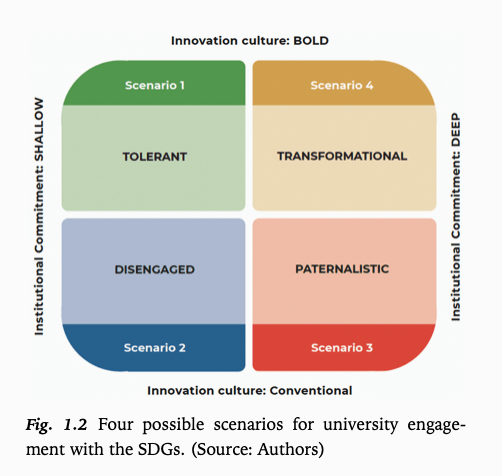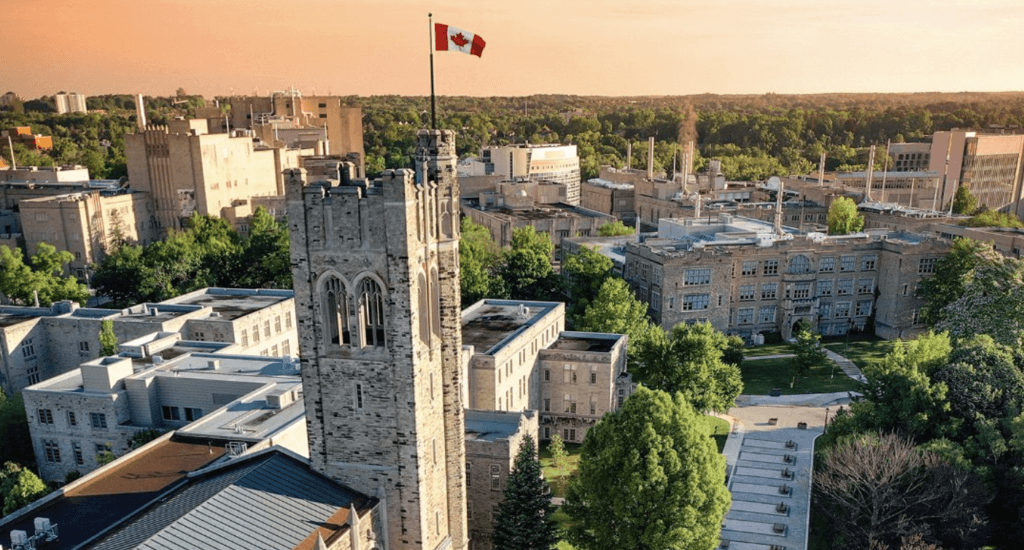The Sustainable Development Goals in Higher Education
In the whole-of-society approach to achieve the Sustainable Development Goals (SDGs), Universities and Colleges, also known as Higher Education institutions (HEI) carry a lot of weight in the global stage and have the potential to play a key role to enable a sustainable future for humanity.
As a product and producer of the mindset that created the very challenges we are facing today, HEI and the SDGs also hold ambiguities, tensions and inconsistencies that need to be critically examined in order to become truly transformative. The HEI-SDG relationship is two way, where both can be a contributor to the solutions while at the same time require a shift in their processes and practices. In other words, an enabler of change and target of change (Steele and Rickards, 2021).
SDG Engagement Scenarios
Based on the two axes of commitment (How deeply will a university commit to the SDGs?) and innovation (How bold and ethical will its innovation culture be?), Steele and Rickards identified four archetypical scenarios of university engagement with the SDGs: tolerant, disengaged, paternalistic or transformative.

Tolerant Scenario
It consists of a shallow institutional commitment with a bold innovation culture. SDGs are niche or a specialist topic, rather than a guiding framework for the whole institution. Radical innovation is happening in specific areas and it is dependent on SDG champions within the HEI.
Disengaged Scenario
It is characterized by a shallow institutional commitment and conventional innovation culture. SDG efforts are weak, sporadic and usually driven by external factors such as funding requirements or third-party rankings.
Paternalistic Scenario
It is expressed through a deeper institutional commitment with a conventional innovation culture. A variety of mandatory and optional mechanisms are in place requiring faculty and staff to use or engage with the SDGs. Efforts tend to raise general awareness about the SDGs and produce innovative results. They can also lead to performative adoption of the SDGs, especially if those are standardized and top-down processes.
Transformative Scenario
It combines a deep institutional commitment with radical innovation. There is an institution-wide engagement with the SDGs in a critical way where the whole community is involved in shaping what that looks like, welcoming diverse epistemological understandings with a flexible approach across domains and projects while maintaining an ethical commitment to their principles.
“The SDGs are not just one among many topic areas within a university, they are a strategic focus and context that demand a new way of working and offer political opportunities for addressing deep structural inequities.”
(Steele and Rickards, 2021)
SDG Integration Aspects
In a transformative scenario, the different aspects of SDG integration can be categorized in two broad groups. External and Internal. External aspects are public facing and include the services provided by the academic institutions. Internal aspects are inward looking and include activities to run the institution. In both groups, academic institutions operate as an agent of change and a target of change. Although the role of agent is more associated with external activities and the role of target is more associated with internal activities.
The external aspects include:
- Education
- Research
- Outreach
The internal aspects include:
- Facilities
- Corporate Finance
- Governance
A roadmap for SDG Integration
Getting Started with the SDGs in Universities is a report produced by the Sustainable Development Solutions Network (SDSN) that compiles examples around the world and offers a model for universities that are willing to adopt a whole-of-university approach to integrate the SDGs. (SDSN Australia/Pacific, 2017)
The Sustainable Development Goals (SDGs), adopted by the United Nations in 2015, are a universal call to action to end poverty, protect the planet, and ensure that by 2030 all people enjoy peace and prosperity. All 193 members of the United Nations are signatories of the SDGs. Canada has its own national implementation strategy. The 17 goals in the SDG framework are interdependent. Actions in one area affect outcomes in others, and development must balance social, economic, and environmental sustainability.
References
Steele, Wendy, and Lauren Rickards. Sustainable Development Goals in Higher Education: A Transformative Agenda? Cham, Switzerland: Palgrave Macmillan, 2021.
Sustainable Development Solutions Network (SDSN) Australia/Pacific. Getting Started With The SDGs In Universities: A Guide For Universities, Higher Education Institutions, And The Academic Sector. Australia/Pacific, Melbourne, 2017, https://resources.unsdsn.org/getting-started-with-the-sdgs-in-universities

